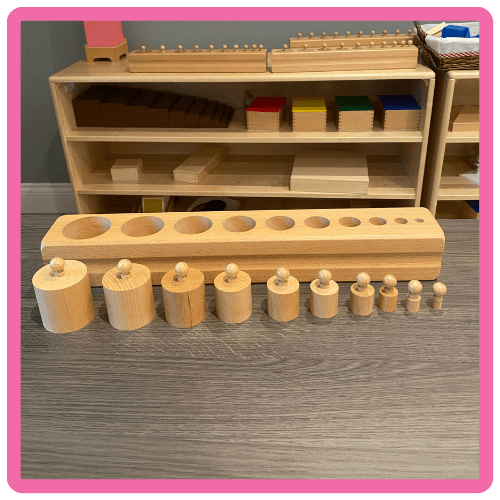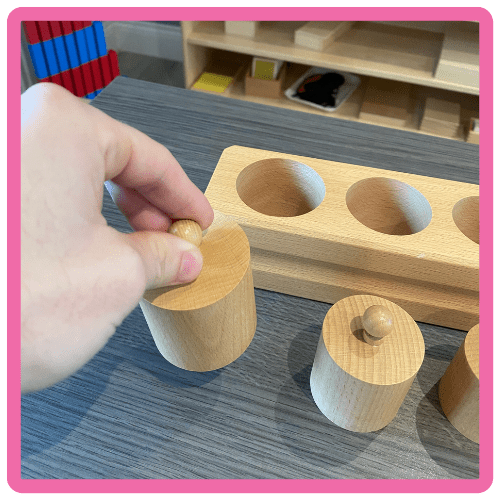Montessori education is renowned for its hands-on approach to learning, and the Knobbed Cylinders are the perfect example of this philosophy in action. In today’s Montessori Spotlight we’ll cover the Knobbed Cylinders!
The Knobbed Cylinders provides an introduction to visual discrimination of size. The three finger grip developed by grasping the Knobbed Cylinders indirectly prepares the child for writing. The cylinders progress in height and diameter.
The Knobbed Cylinder is part of the Montessori Sensorial curriculum. It is a set of wooden cylinders, each with a knob on top. These cylinders come in various sizes and are made from wood, which feels warm and natural in the hands of a child. They are designed to help children refine their visual discrimination, depth perception, and fine motor skills.
The Knobbed Cylinder material is typically presented on a flat surface with the cylinders arranged in a specific order, from largest to smallest. Children are encouraged to work with the material in the following way:

Starting Point:
Begin with the Knobbed Cylinders neatly arranged on a tray or mat, in order from the largest to the smallest.
Introduction:
Sit beside the child and introduce the purpose of the Knobbed Cylinders. Explain that they help with understanding size, developing fine motor skills, and exploring depth perception.
Invite the Child:
Invite the child to join you at the table and participate in the activity.
Initial Exploration:
Ordering the Cylinders:
Grasping and Placing:

Independence and Control of Error:
Observation and Guidance:
Clean-Up:
Encourage Repetition:
Encourage the child to revisit the activity whenever they wish. Repetition is vital for skill refinement in Montessori education.
Conclusion:
The Knobbed Cylinders, a fundamental Montessori material, offer several significant benefits to a child’s development. Some advantages can include:
The Knobbed Cylinders are a powerful tool for enhancing a child’s sensory perception. As children explore the cylinders, they develop a heightened awareness of size, shape, and dimension. This material helps them refine their visual discrimination, allowing them to distinguish subtle differences in the dimensions of each cylinder. This enhanced sensory perception is a foundational skill that aids in understanding more complex concepts in various subjects, particularly mathematics.
Working with the cylinders requires precise and coordinated movement. Children learn to use a pincer grip (thumb and forefinger) to grasp the knobs and carefully place the cylinders back in their slots. This fine motor skill development is crucial for various everyday tasks, including writing, drawing, and activities like buttoning clothing. This activity lays the groundwork for refined hand control.
The Knobbed Cylinders are self-correcting. If a child places a cylinder in the wrong order or slot, they can see the mismatch and correct it themselves. This aspect of self-correction fosters independence and critical thinking. Children learn to identify and rectify their mistakes, promoting a sense of empowerment and self-reliance. These problem-solving skills extend beyond the activity and are valuable throughout a child’s educational journey.
Thank you for reading the latest edition of Material Spotlight: Knobbed Cylinders.
Tell us in the form below, what Montessori Material Spotlight we should cover next!